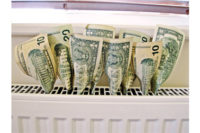What Will Buildings Look Like in 100 Years?
Government, industry contemplate the future of US structures
![Buildings of the future will] be able to transact with the grid, know which systems are working, be able to monitor the status of the buildingââ¬â¢s health, and be able to cater to the needs of individuals.](https://www.achrnews.com/ext/resources/2015/11-2015/11-16-2015/photo-1430834500855-3873f1e078f5.jpg?t=1447341824&width=1080)
MORE THAN A BUILDING: “[Buildings of the future will] be able to transact with the grid, know which systems are working, be able to monitor the status of the building’s health, and be able to cater to the needs of individuals,” said Roland Risser, director of building technologies office, U.S. Department of Energy (DOE).

PREDICTING THE FUTURE: The Buildings of the Future project, an endeavor spearheaded by the Pacific Northwest National Laboratory (PNNL) and the U.S. Department of Energy, is focused on imagining what buildings of the future will look like, how they’ll interact with humans, and how they’ll improve our lives and the Earth.
Buildings today are about as smart as the average kitchen oven. And, in 100 years, the hope is they’ll be as smart as today’s automobiles.
Those are the words of Rolan Risser, director of building technologies office, U.S. Department of Energy (DOE), who shared the revelation during a July 31 meeting of the Buildings of the Future research project in Washington, District of Columbia.
“Think about how your car operates. Buildings will soon have those capabilities — they’ll be self-aware, know when their systems are running, be able to tell managers when something’s wrong, be able to self-configure, and be able to heal themselves, to some extent,” said Risser. “[Buildings of the future will] also be able to transact with the grid, know which systems are working, be able to monitor the status of the building’s health, and be able to cater to the needs of individuals.”
BUILDINGS OF THE FUTURE
The Buildings of the Future project, an endeavor spearheaded by the Pacific Northwest National Laboratory (PNNL) and the DOE, aims to develop a vision for what U.S. commercial and residential buildings could become in 100 years.
Project facilitators are aiming to investigate key design and technology trends and current unknown areas that could revolutionize the built environment across the areas of energy and water use, greenhouse gas emissions, material consumption, building control and communication, resilient design, occupant health and productivity, and cyber and physical security. Researchers shaped this vision using four lenses: utilities, environment, occupants, and markets.
Group members also considered related topics that may directly impact the long-term trajectory of buildings, such as modes of transportation, electric grid integration, and community-scale planning, and compile a list of long-term goals and metrics to quantify achievements.
FUTURE ATTRIBUTES, CONSTRAINTS
Through surveys conducted by the Buildings of the Future participants, a next-generation building’s top attribute will be its ability to increase the health, productivity, and wellbeing of occupants. Respondents predict the scarcity of resources as the top constraint future developers will endure.
Advances in material science and manufacturing and changes in the energy market or the cost of energy were identified as the top two factors influencing construction going forward.
“Will there be another economic downturn [in the next 100 years]? Yes. It’s going to happen. Will there be environmental conditions, such as disasters, hurricanes, etc.? Yes. Buildings of the future must be flexible and adaptable to these conditions,” Risser said. “We have to make sure our buildings are ready for those factors. We have to plan so that buildings are immune to these events or can be quickly recovered.”
The project is expected to draw to a close very soon. Upon completion, a synthesis will be targeted for a leading peer-reviewed journal. This published document will detail visions for a well-planned future for buildings where advances stem not only from the reduced use of resources, but also from social and environmental benefits.
EFFICIENCY OBSTACLES
Energy efficiency has been improving dramatically over the last five years, and while it’s unlikely this rate of improvement will continue (e.g. 30 percent improvement in code requirements from 2004 to 2010), we can expect to see buildings that are heated and cooled using passive systems, a high degree of integration, tight and bidirectional grid connection, analytics, and more on-site generation, said Laura Van Wie McGrory, international policy vice president, Alliance to Save Energy (ASE).
“Among the looming challenges, transitioning professional orientation, trade skills, business models, regulations, and supply chains to optimize systems including mechanical systems and their interaction with other building systems — not just individual pieces of equipment — remain among the more impactful,” Van Wie McGrory said.
“In the buildings sector, efficiency measures and programs have focused mainly on individual devices or on whole-building performance; however, across the spectrum of building energy uses — from home appliances to lighting, commercial and residential HVAC, and data/telecomm centers — industry experts and efficiency advocates are looking beyond familiar energy-saving measures to consider opportunities not easily captured by either efficient individual devices or whole-building performance,” said Jeff Harris, senior policy and technology advisor, ASE. “This is the primary focus of the Alliance to Save Energy-led Building Systems Efficiency Initiative (SEI).”
INDUSTRY THOUGHTS
Mike Schwartz, CEO of Daikin Applied, said the future consists of numerous challenges, including continued pressure to attain higher energy-efficiency levels and further reduce carbon emissions with an increasing focus on achieving net zero.
“With commercial buildings comprising a substantial percentage of the energy use and demand on our energy grid, it’s incumbent on our teams to deliver innovation from design, solutions, equipment, and service to help our customers maximize efficiency and minimize environmental impact,” he said. “As the industry feels the pressure of regulations and standards, we’re leading the way with new standards in performance and efficiency through our Magnitude Magnetic Bearing chillers, Rebel rooftop units, inverter compressor technology, and the flexibility and scale of our Vision air handlers.
“As many systems are antiquated, increasing requirements are pushing the industry to move faster than many may have thought possible,” added Schwartz.
While the future is difficult to predict, building owners will certainly need to manage assets more effectively and leverage demand response and utility information to save more, said Schwartz.
“With our Intelligent Equipment™ platform, we’re delivering useful analytics and outputs to give building owners the insight to understand energy usage and make data-driven decisions that save energy and resources,” he said. “We see the IoT discussion gaining momentum and traction in buildings, and we’re on the leading edge with our cloud-based platform.”
John Galyen, president of Danfoss North America, said the nation is faced with an aging building stock, as only 1 percent of buildings are considered “new.” Deep retrofits are required to fit to purpose, performance, and efficiency, particularly when existing buildings are repurposed.
“We’re reaching what some describe as ‘MaxTech,’ where individual heating and cooling components are approaching their maximum efficiency levels and are reaching the point of diminishing returns,” said Galyen. “The physical limits and increased first cost of individual product technology has led the industry to look beyond the component to the whole-building system and perhaps beyond individual buildings to clusters of buildings. There are vast efficiencies to be gained through better design and management of the inter-relationships between individual pieces of equipment.”
Danfoss is ramping up its investment in variable speed fans, motors, pumps, and compressors as “Variable-speed solutions will be an important enabler to reach higher efficiency levels and increased performance,” said Galyen.
Advanced technologies and more sophisticated refrigerants will be necessary to propel America’s infrastructure into the next century, Galyen noted.
“For the vast inventory of existing buildings, we need inducements to upgrade to new technology instead of repairing old inefficient products. Such policies could produce immediate energy savings,” Galyen said. “Danfoss is focusing its research and development on energy-efficient solutions and low-GWP [global warming potential] technologies. We’re investing in products and solutions that are extremely intuitive and easier to install, maintain, and troubleshoot.”
CONTRACTORS OF THE FUTURE
While many contractors admit they’re most focused on the current or next heating or cooling season, a few were willing to look into their proverbial crystal balls and offer their predictions.
“[In the future] Comfort strategies will condense down to our personal envelopes and use pervasive, smart technology to drive it,” said Rick Tullis, president of Capstone Mechanical in Waco, Texas. “For instance, everyone will have a personal smart device — worn, carried, or implanted — that will constantly monitor a person’s body temp, oxygen level, heart rate, location, and more. This information will be pulled into the smart building automation system and used to make decisions on temperature set points, ventilation rates, and airflow rates into each space. Even in large spaces, comfort control will be very personalized.”
Travis Smith, owner of Sky Heating and Air Conditioning in Portland, Oregon, said future contractors will most likely be maintaining systems with refrigerants that aren’t imaginable by today’s scientists.
“I can only imagine that we’ll be reaching the theoretical limits of HSPF and SEER for systems sooner than later,” he said. “I see us using a lot more cooling in the future as the temperature warms and we hit more extremes for weather. I feel that fresh air for commercial and residential buildings will fully be required, as homes and buildings will be sealed up as much as they possibly can be. On the flip side, it could be that renewables become so efficient that heating and cooling efficiencies hardly matter because each building will serve as its own power source. There are so many ways this could go right now.”
Rich Morgan, president of Magic Touch Mechanical Inc. in Mesa, Arizona, foresees a future where everything will be ductless, zoned by room, and controlled completely by sensors.
“Everything will be wireless, and IAQ and humidity control will be built into standard equipment,” he said. “There will be advancements in variable-speed technology, and single- and two-stage equipment will be found only in HVAC museums.”
Contractors operating in the 2100s will most likely have to pay close attention to every aspect of a building’s operation.
“Contractors will have to look at every change in the building — including tenancy turnovers and tenant improvements, routine equipment maintenance, lighting or façade renovations, equipment or lighting system end-of-life replacements, and more — as a key chance for upgrading efficiency at a bargain price,” said ASE’s Harris. “They should try to future-proof new or renovated buildings and systems as much as possible, allowing for multiple cycles of future renovations, technology upgrades, and changes in occupancy requirements and usage types. Contractors should also try to shock-proof systems against extreme weather events, grid outages, and other contingencies by building in fail-soft modes, simpler user interfaces, reliable monitoring, and more.”
Publication date: 11/16/2015
Want more HVAC industry news and information? Join The NEWS on Facebook, Twitter, and LinkedIn today!









